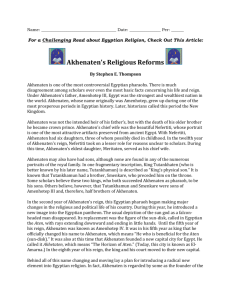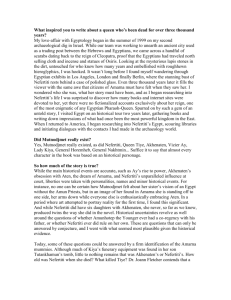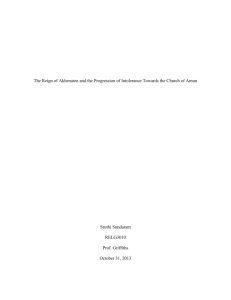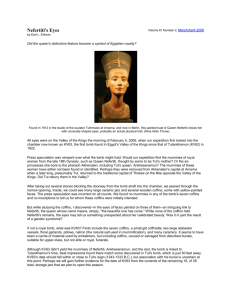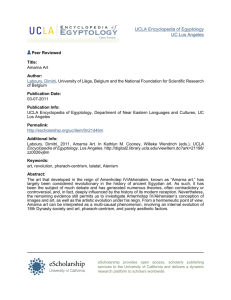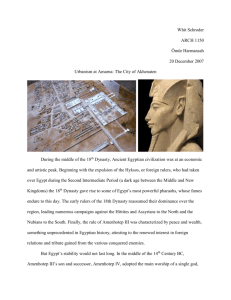Pharaohs of the Sun
advertisement
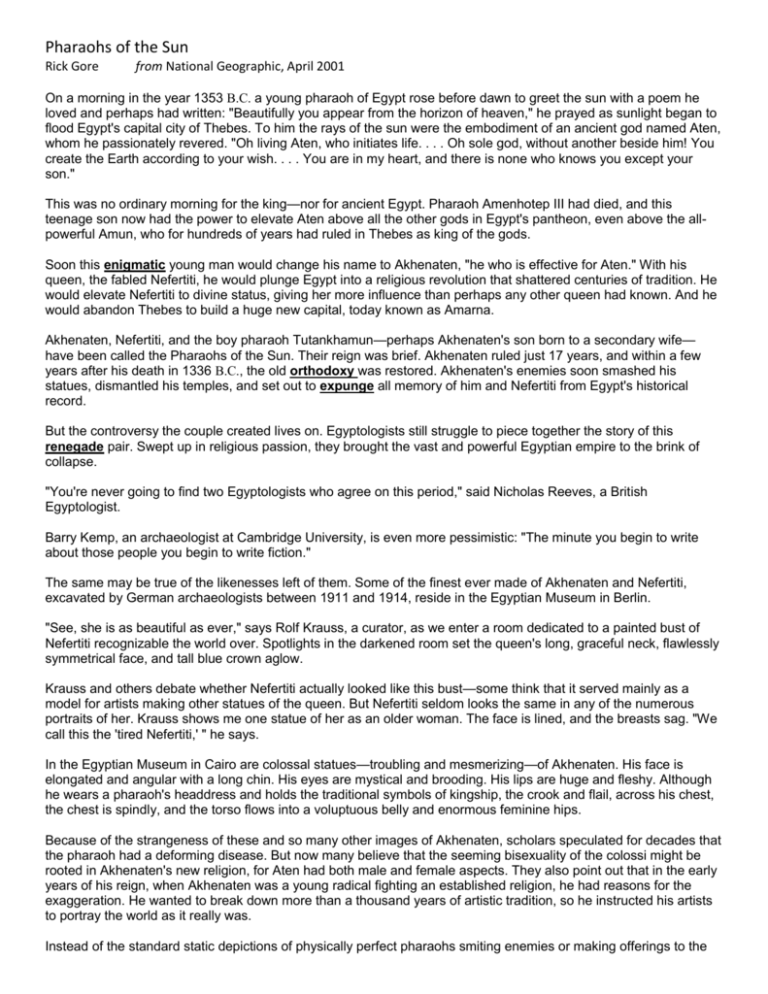
Pharaohs of the Sun Rick Gore from National Geographic, April 2001 On a morning in the year 1353 B.C. a young pharaoh of Egypt rose before dawn to greet the sun with a poem he loved and perhaps had written: "Beautifully you appear from the horizon of heaven," he prayed as sunlight began to flood Egypt's capital city of Thebes. To him the rays of the sun were the embodiment of an ancient god named Aten, whom he passionately revered. "Oh living Aten, who initiates life. . . . Oh sole god, without another beside him! You create the Earth according to your wish. . . . You are in my heart, and there is none who knows you except your son." This was no ordinary morning for the king—nor for ancient Egypt. Pharaoh Amenhotep III had died, and this teenage son now had the power to elevate Aten above all the other gods in Egypt's pantheon, even above the allpowerful Amun, who for hundreds of years had ruled in Thebes as king of the gods. Soon this enigmatic young man would change his name to Akhenaten, "he who is effective for Aten." With his queen, the fabled Nefertiti, he would plunge Egypt into a religious revolution that shattered centuries of tradition. He would elevate Nefertiti to divine status, giving her more influence than perhaps any other queen had known. And he would abandon Thebes to build a huge new capital, today known as Amarna. Akhenaten, Nefertiti, and the boy pharaoh Tutankhamun—perhaps Akhenaten's son born to a secondary wife— have been called the Pharaohs of the Sun. Their reign was brief. Akhenaten ruled just 17 years, and within a few years after his death in 1336 B.C., the old orthodoxy was restored. Akhenaten's enemies soon smashed his statues, dismantled his temples, and set out to expunge all memory of him and Nefertiti from Egypt's historical record. But the controversy the couple created lives on. Egyptologists still struggle to piece together the story of this renegade pair. Swept up in religious passion, they brought the vast and powerful Egyptian empire to the brink of collapse. "You're never going to find two Egyptologists who agree on this period," said Nicholas Reeves, a British Egyptologist. Barry Kemp, an archaeologist at Cambridge University, is even more pessimistic: "The minute you begin to write about those people you begin to write fiction." The same may be true of the likenesses left of them. Some of the finest ever made of Akhenaten and Nefertiti, excavated by German archaeologists between 1911 and 1914, reside in the Egyptian Museum in Berlin. "See, she is as beautiful as ever," says Rolf Krauss, a curator, as we enter a room dedicated to a painted bust of Nefertiti recognizable the world over. Spotlights in the darkened room set the queen's long, graceful neck, flawlessly symmetrical face, and tall blue crown aglow. Krauss and others debate whether Nefertiti actually looked like this bust—some think that it served mainly as a model for artists making other statues of the queen. But Nefertiti seldom looks the same in any of the numerous portraits of her. Krauss shows me one statue of her as an older woman. The face is lined, and the breasts sag. "We call this the 'tired Nefertiti,' " he says. In the Egyptian Museum in Cairo are colossal statues—troubling and mesmerizing—of Akhenaten. His face is elongated and angular with a long chin. His eyes are mystical and brooding. His lips are huge and fleshy. Although he wears a pharaoh's headdress and holds the traditional symbols of kingship, the crook and flail, across his chest, the chest is spindly, and the torso flows into a voluptuous belly and enormous feminine hips. Because of the strangeness of these and so many other images of Akhenaten, scholars speculated for decades that the pharaoh had a deforming disease. But now many believe that the seeming bisexuality of the colossi might be rooted in Akhenaten's new religion, for Aten had both male and female aspects. They also point out that in the early years of his reign, when Akhenaten was a young radical fighting an established religion, he had reasons for the exaggeration. He wanted to break down more than a thousand years of artistic tradition, so he instructed his artists to portray the world as it really was. Instead of the standard static depictions of physically perfect pharaohs smiting enemies or making offerings to the gods, artists gave the new king a much more realistic appearance. "Akhenaten probably didn't have the greatest physique by American standards," says James Allen, a specialist on the period at the Metropolitan Museum of Art in New York. "He had the easy life in the palace." For the first time, artists routinely portrayed the pharaoh in informal situations—being affectionate with Nefertiti or playing with his children. They also painted scenes of life and nature—wheat rippling in the wind, farmers plowing, birds taking flight. In truth, Akhenaten unleashed a creative furor that gave rise to perhaps the finest era of Egyptian art. "You could compare him to a cult leader," says Rita Freed, an Egyptologist from the Boston Museum of Fine Arts. Experts continue to argue whether he was the world's first monotheist. He insisted on one supreme god—an allpowerful creator who manifested himself in the sunlight. But he perceived himself and Nefertiti as extensions of that god—also deserving of worship. Akhenaten's rebellion began with his father, the strong-willed pharaoh Amenhotep III, who ruled for 37 years during a golden age of Egyptian empire. Amenhotep III tapped the wealth of that empire to build an unprecedented series of monuments. These included elaborate constructions at Karnak and Luxor, religious centers of the god Amun, patron of Thebes. Amun became increasingly powerful after Thebes regained control of Egypt around 1520 B.C. His name means Hidden One, and he resided in the inner sanctum of his temple at Karnak, where his priests fed, washed, and clothed a statue of him. Amun soon merged with the ancient sun god Re and became Amun-Re. Pharaoh himself was regarded as the son of Amun-Re. His divine authority could be renewed only by the Hidden One each year in a festival called Opet. Late in his reign, and perhaps chafing from political friction with the priests of Amun, Amenhotep III decided that he was not only the son of Amun but also the incarnation of Re—and thus at least equal to Amun. He began building monuments to his own divinity, including a vast funerary temple across the Nile from Thebes. This temple featured two 65-foot-high (20 meter), 720-ton (653 metric ton) quartzite statues of himself that he declared should gleam into people's eyes like the rising Aten. The ruins of those statues are famed as the Colossi of Memnon. The stage was thus set for the entrance of Akhenaten, who came to the throne as Amenhotep IV. Some scholars argue that Akhenaten and his father ruled together as co-regents for several years. Ray Johnson, a specialist at the University of Chicago, believes the father lived on for many years, yielding power to his son and accompanying him to Amarna. But most now contend that Akhenaten ruled without his father, perhaps driven to outdo him. Akhenaten was probably already married to Nefertiti when he ascended the throne. Perhaps both were children when they wed, as Akhenaten's father and mother, Queen Tiye, had been. No one knows where Nefertiti came from. Her name means "the beautiful one has come," which once led scholars to assume she was foreign-born. Today many believe she was from a town now called Akhmim and belonged to the same influential family as Queen Tiye. Wherever Nefertiti was born, she was a part of Akhenaten's revolution from the beginning. "This is where he started," says Rita Freed as we stand outside the towering gates, or pylons, of Karnak, which sprawls across some 250 acres (101.2 hectares) near the modern city of Luxor. The sun beats down on us as once it did on Akhenaten, an inescapable force that infuses the bricks and walls and statues and enervates the throngs of visitors who trudge between the pylons. "By the time Akhenaten came to the throne, this was the greatest shrine in the land," Freed says, explaining that each pharaoh was obliged to make an addition to the Karnak complex. We walk to a 40-foot-high (12.2 meter) relief Akhenaten had carved on a wall of Amun-Re's temple soon after taking power. It's a traditional "smiting scene" for pharaohs. Akhenaten holds his enemies by their hair and is about to kill them. "This was a major project," says Freed. "But it's unfinished. At some point Akhenaten said, 'Hold everything.'" "His was a strange new vision," says Robert Vergnieux of the University of Bordeaux in France. "Since the Egyptians' god was now the sunlight, they didn't need statues in dark inner sanctums. So they built temples without roofs and performed their rituals directly under the sun." "For a short time the Egyptians believed the sun god had come back to Earth in the form of the royal family," says Ray Johnson. "There was a collective excitement that becomes tangible in the art and architecture. The whole country was in jubilee. It's one of the most astonishing periods in world history." Vocabulary: Define the following words in context. Then look them up and write the dictionary definition to assess how close you came to the definition. Word Defined in Context Dictionary Definition enigmatic expunge orthodoxy renegade unprecedented gleam tangible jubilee EOC Style questions 1. Which of the following quotes from the article best summarizes the main idea? a. “Krauss and others debate whether Nefertiti actually looked like this bust…” b. “Because of the strangeness of these and so many other images of Akhenaten, scholars speculated for decades that the pharaoh had a deforming disease.” c. “For the first time, artists routinely portrayed the pharaoh in informal situations..” d. “But the controversy the couple created lives on. Egyptologists still struggle to piece together the story of this renegade pair.” 2. What is significant about the way Akhenaten is depicted in art? a. It shows Akhenaten’s radical views and attempt to break tradition. b. It was intended to show Akhenaten was weaker than Nefertiti. c. It portrayed him as a weak leader. d. It showed how family meant more to him than his civic duties. 3. What is the effect of the following quote? "You could compare him to a cult leader," says Rita Freed, an Egyptologist from the Boston Museum of Fine Arts. Experts continue to argue whether he was the world's first monotheist. He insisted on one supreme god— an all-powerful creator who manifested himself in the sunlight. But he perceived himself and Nefertiti as extensions of that god—also deserving of worship. a. b. c. d. It proves that Akhenaten’s hubris brought him to his downfall. It proves that power and recognition for his family was important. It proves that the Egyptian people were fully supportive of the radical leader’s vision. It proves that Akhenaten was the first identified monotheist. Constructed Response: Answer the following question on a sheet of notebook paper. Make sure to include a topic sentence, textual evidence, elaboration, and a closure. YOU CAN ONLY USE 5 LINES!!!!!!!!!!!!!!!!!!!!!!!!!!!!1 1. Based on the article, how can a reader best sum up Akhenaten’s character?
